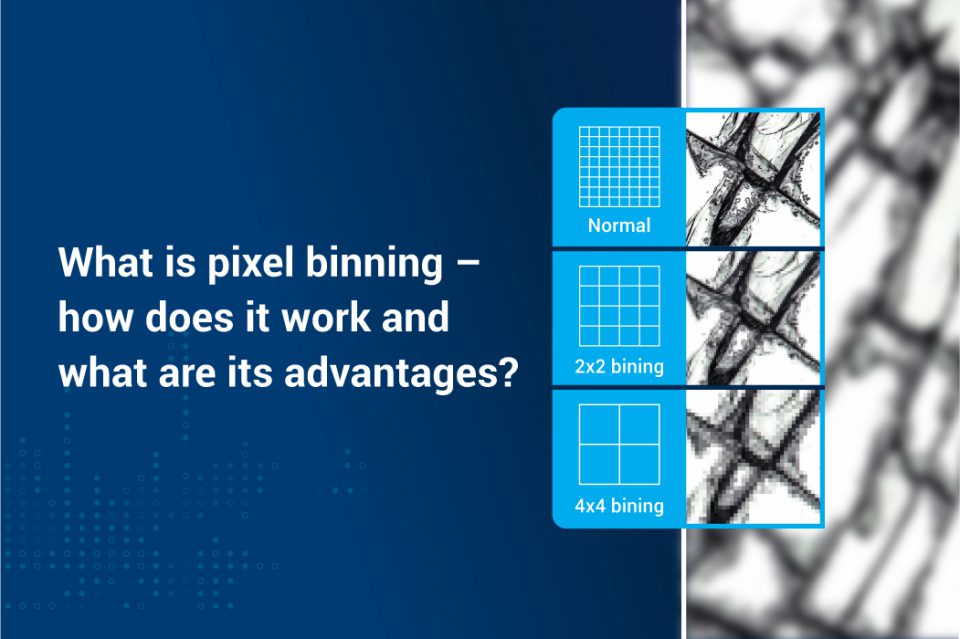Pixel binning – or image binning – is a feature that is becoming increasingly common in camera-based applications. However, it’s also sparked a lot of debate regarding whether it’s really necessary at all. The term “pixel binning” has been thrown casually in recent years, as it’s a function included in many modern smartphones. Even if the end-user may not have heard of it, the fact is that pixel binning makes a significant difference to image quality.
Though pixel binning is more often discussed when it comes to smartphone cameras, it has started finding its application in machine vision and embedded vision as well. For instance, See3CAM_CU135M – a 13MP monochrome USB camera – from e-con Systems™ comes with the 2×2 and 4×4 pixel binning feature that helps to enhance its sensitivity.
In this blog, we will attempt to learn what Pixel Binning means – and how exactly it ensures superior image quality.
How do pixels play a role in embedded vision and cameras?
To grasp the concept of pixel binning, it is first important to understand what a pixel is. Pixels – also known as photosites – are physical bits on a camera sensor that catch light in order to create pictures. Microns (a millionth of a meter) are used to quantify pixel size, and anything less than one micron is considered to be tiny.
A larger pixel can collect more light than a smaller pixel. Thus, in a dark bar or at nightfall, when light is scarce, you typically want to go with a sensor with a large pixel size to be able to catch more light to achieve the desired image quality. On the other hand, a smaller pixel helps you to capture tiny objects and details. For instance, See3CAM_130 – 13MP autofocus USB camera – from e-con Systems™ comes with a pixel size of 1.1μm (which is considered small), whereas See3CAM_CU81 – 4K HDR USB camera – has a pixel size of 3 μm (which is considered large).
Now the challenge is that, if you want a high-resolution camera (like See3CAM_130), you are likely to have a smaller pixel size. This limits the sensitivity of the camera. Whereas if you go for a camera with a large pixel size, the sensor size will increase. If your application demands a small form factor camera, then this is a bottleneck. Also, if you want to enjoy the other benefits of a small pixel size camera – such as the ability to capture tiny objects – at the same time achieve good sensitivity, the conventional approach will do no good.
This is where image binning comes to the rescue. An image binning camera is capable of mimicking a larger pixel size without having to go for a larger sensor. We will learn more about the concept in detail in the upcoming sections.
What is Pixel Binning?
Pixel binning is a one-of-a-kind solution to help achieve enhanced sensitivity for small pixel size cameras. The size of the sensor’s pixels is effectively increased by merging the electric current of many pixels near each other. In other words, after 4-to-1 pixel binning (or 2×2 pixel binning), a sensor with a pixel size of 1.1μm x 1.1μm will now have a size of 2.2μm x 2.2μm. That’s why pixel binning allows the camera to produce better quality images in low-light circumstances by increasing the size of the pixels on the sensor.
How does Pixel Binning work?
In pixel binning, the demosaicing method merges information from four pixels into one (in the case of a 4-to-1 binning), making the technology effectively an Image Signal Processor level implementation. Let’s call pixel binning what it is: It combines pixels in a 2×2 grid, 2×1 grid, 3×3 grid, or a 4×4 grid into one. Each pixel’s information is now integrated into a single big Super Pixel.
Pixel binning is the process of combining data from four neighboring pixels into a single “superpixel,” helping camera manufacturers squeeze the last bit of performance out of existing sensor designs. As a result, the image’s effective resolution is 1/4th of the sensor’s resolution (in the case of a 4-to-1 or 2×2 pixel binning). However, this doesn’t cause a challenge in a vast majority of embedded vision applications since cameras while capturing images in low light environments, can typically compromise on resolution.
What are the advantages of Image or Pixel Binning
We have already touched upon the most important advantages of image binning. Let us a have a comprehensive look at them here.
- With pixel binning, the sensor’s sensitivity is greatly increased which is extremely useful in night vision applications and low light environments.
- Different types of pixel binning (2×2, 3×3, 4×4, etc) offers you the flexibility to find the right resolution-pixel size combination. This is helpful when you wish to go for a customized camera solution to fit your application requirements.
- As embedded systems are getting smaller and smaller, a camera with image binning can help you limit your camera size, at the same time achieving the required sensitivity. This also gives product developers the flexibility to offer more space to other hardware components used in the device.
The benefits of pixel binning may not be significant enough in bright light to justify the resolution trade-off. So it is a good idea to opt for pixel binning only when your application demands it. You could consult an embedded camera manufacturer like e-con Systems™ to guide you through the camera selection process.
Conclusion
Pixel binning is a great technique to enhance images. But majority of the time, the goal of an effective embedded camera solution would be to achieve other imaging goals such as autofocus, high dynamic range, frame rate, exposure time, etc. So pixel binning might not be required in most camera-based applications. Also, while it is a great stop-gap solution to the low light problem, it still can’t achieve results comparable to cameras with large pixel size.
We hope we helped clear some of the confusion on pixel binning. If you have any further queries on the topic, please feel free to leave a comment. We shall get back to you as soon as possible.
Camera with pixel binning from e-con Systems™
e-con Systems™ is an embedded camera manufacturer with close to two decades of experience in the space. Among its wide portfolio of cameras, See3CAM_CU135M – 13MP monochrome USB camera – comes with the 2×2 and 4×4 pixel binning feature that significantly enhances its sensitivity. Along with this, features such as high resolution, absence of color filter arrays, small pixel size, etc make this camera an ideal fit for applications such as digital microscopes, automatic number plate recognition, and quality inspection.
If you are looking for any help in integrating See3CAM_CU135M or other camera modules, USB 3.0 cameras, GMSL cameras, or MIPI cameras into your product, please write to us at camerasolutions@e-consystems.com. You could also visit our Camera Selector to get a full view of e-con Systems™’ camera portfolio.

Prabu is the Chief Technology Officer and Head of Camera Products at e-con Systems, and comes with a rich experience of more than 15 years in the embedded vision space. He brings to the table a deep knowledge in USB cameras, embedded vision cameras, vision algorithms and FPGAs. He has built 50+ camera solutions spanning various domains such as medical, industrial, agriculture, retail, biometrics, and more. He also comes with expertise in device driver development and BSP development. Currently, Prabu’s focus is to build smart camera solutions that power new age AI based applications.




